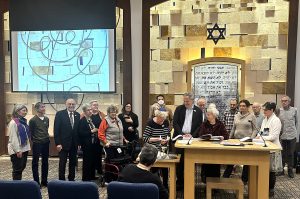 Temple B’nai Tikvah celebrated a very important group of donors at services on Shabbat Friday, February 28, 2025. It was in honour of contributors to our Life & Legacy program. They are members who have named TBT in their insurance policies and/or wills. Rabbi Mark Glickman invited the group to say a blessing over the Shabbat candles. During his sermon, he quoted the Torah. “The portion begins with God telling Moses to have the Israelites ‘Bring me a gift…from everyone whose heart so moves them.’ (Exodus 25:2) Notably, Moses doesn’t tell them that the gift is for him – Moses. Instead, the gift is for God.”
Temple B’nai Tikvah celebrated a very important group of donors at services on Shabbat Friday, February 28, 2025. It was in honour of contributors to our Life & Legacy program. They are members who have named TBT in their insurance policies and/or wills. Rabbi Mark Glickman invited the group to say a blessing over the Shabbat candles. During his sermon, he quoted the Torah. “The portion begins with God telling Moses to have the Israelites ‘Bring me a gift…from everyone whose heart so moves them.’ (Exodus 25:2) Notably, Moses doesn’t tell them that the gift is for him – Moses. Instead, the gift is for God.”
Rabbi Glickman went on to say, “Life & Legacy is important because the program allows us to give and to keep giving in perpetuity. By participating in Life & Legacy, we can give gifts to God over and over again, thus creating opportunities for more people to have deeply meaningful Jewish experiences that so many of us experience at B’nai Tikvah. To have them long into the future.”
